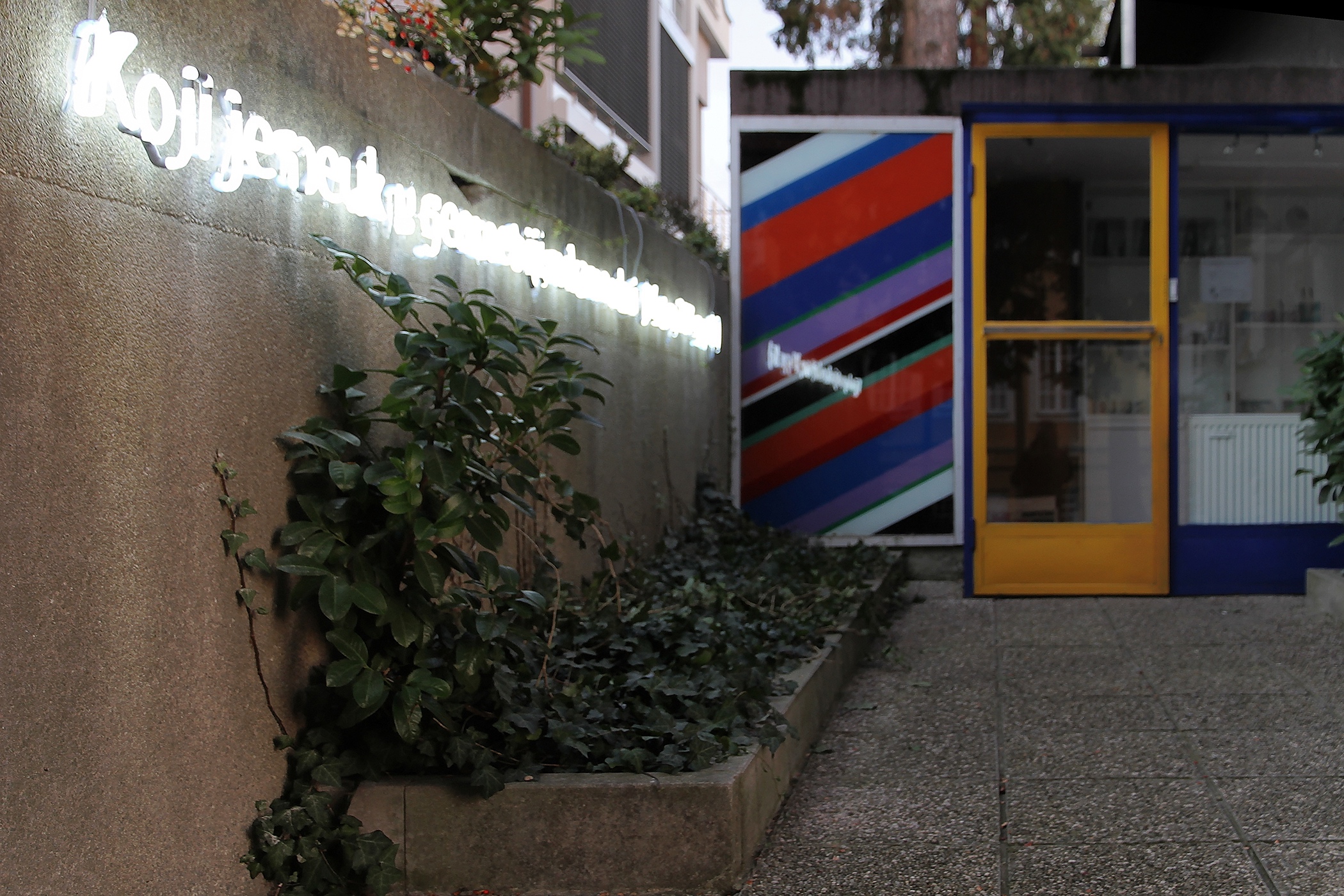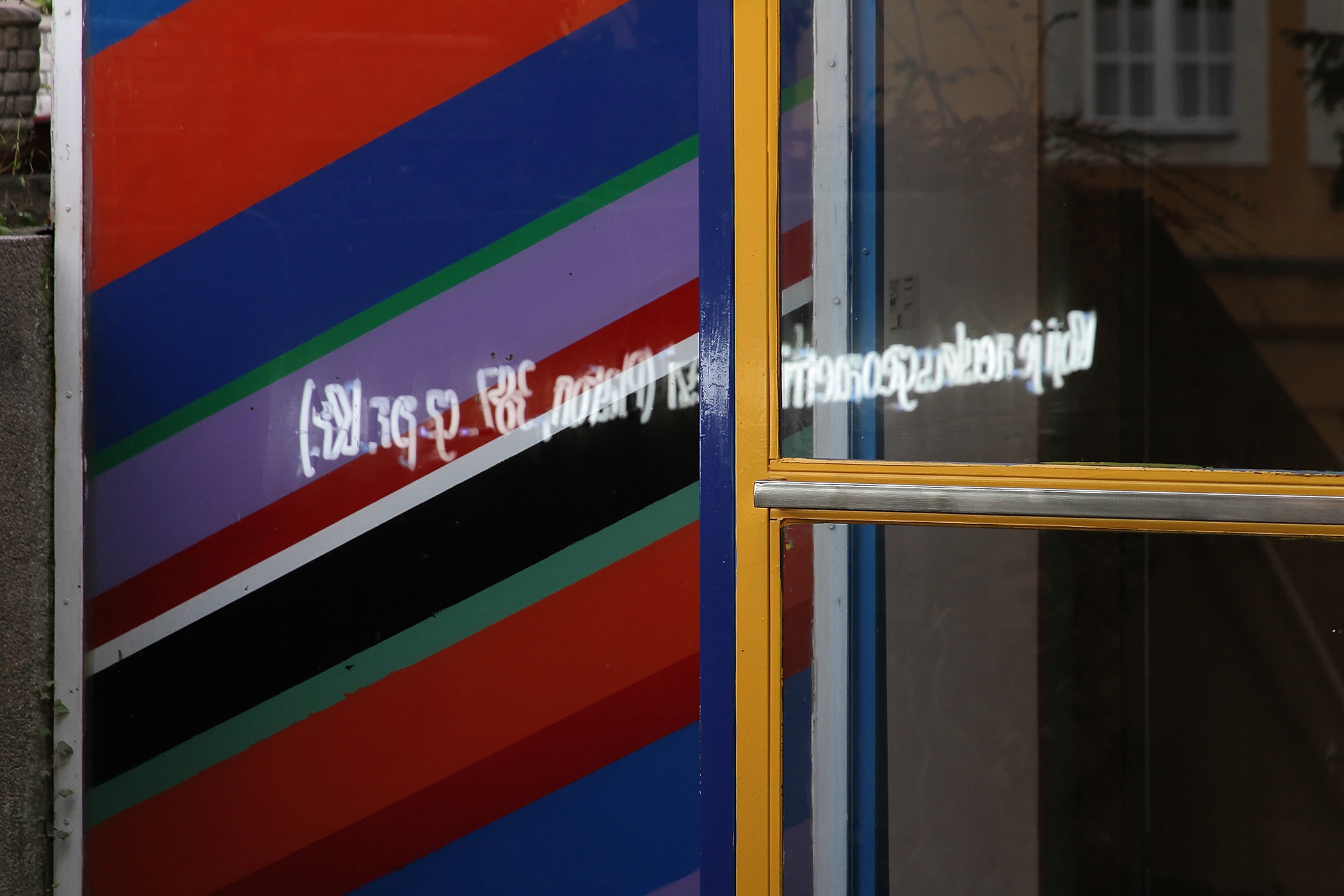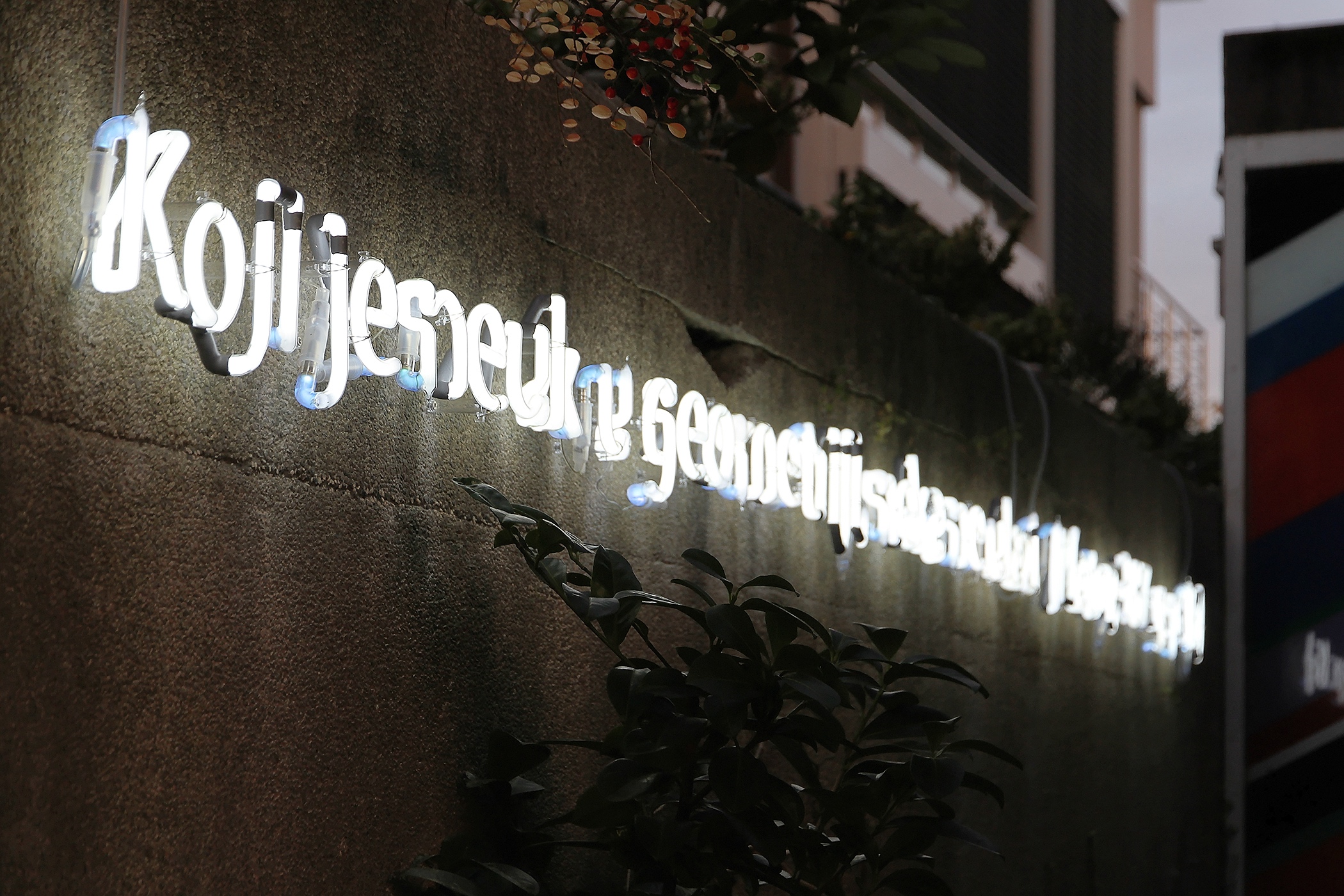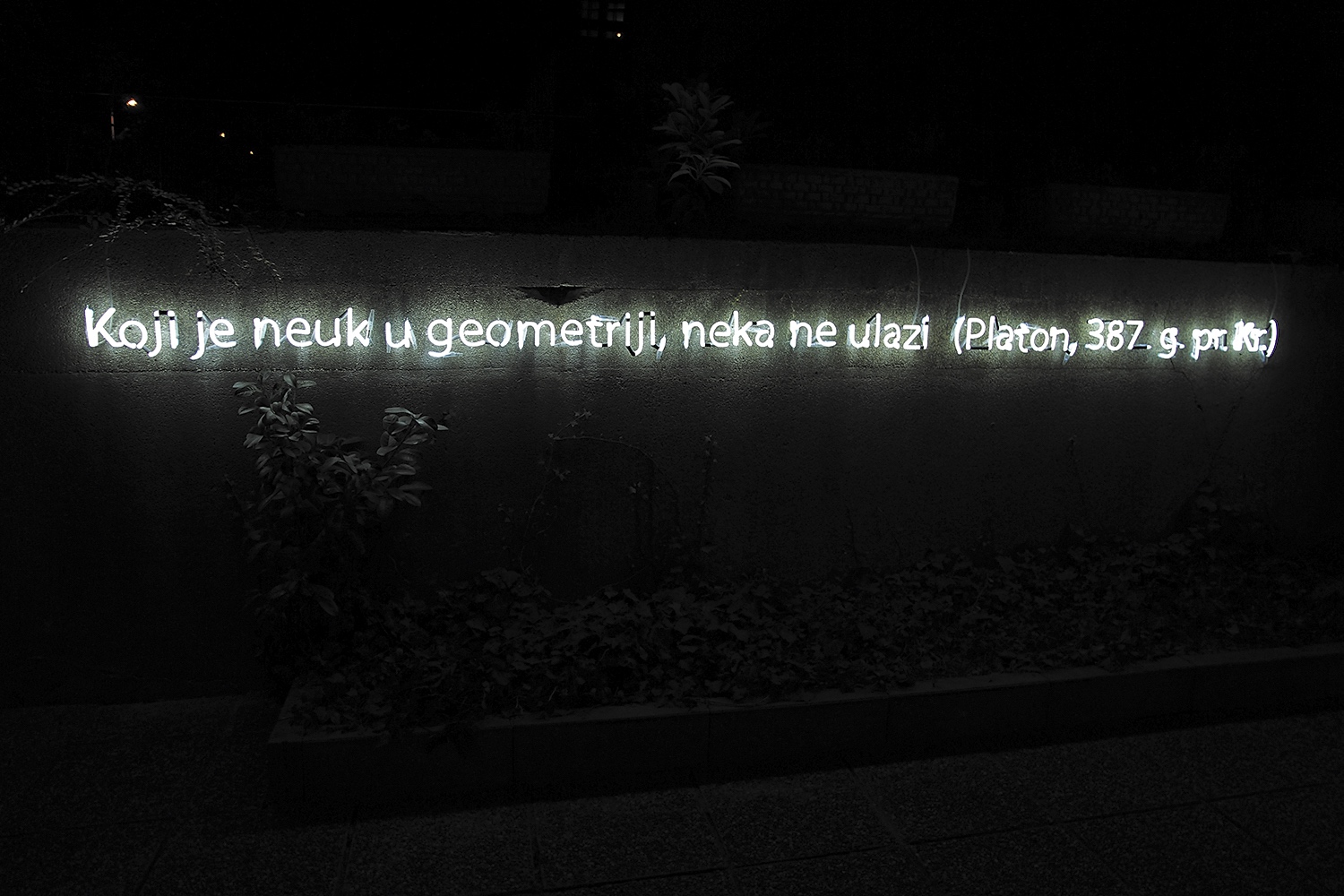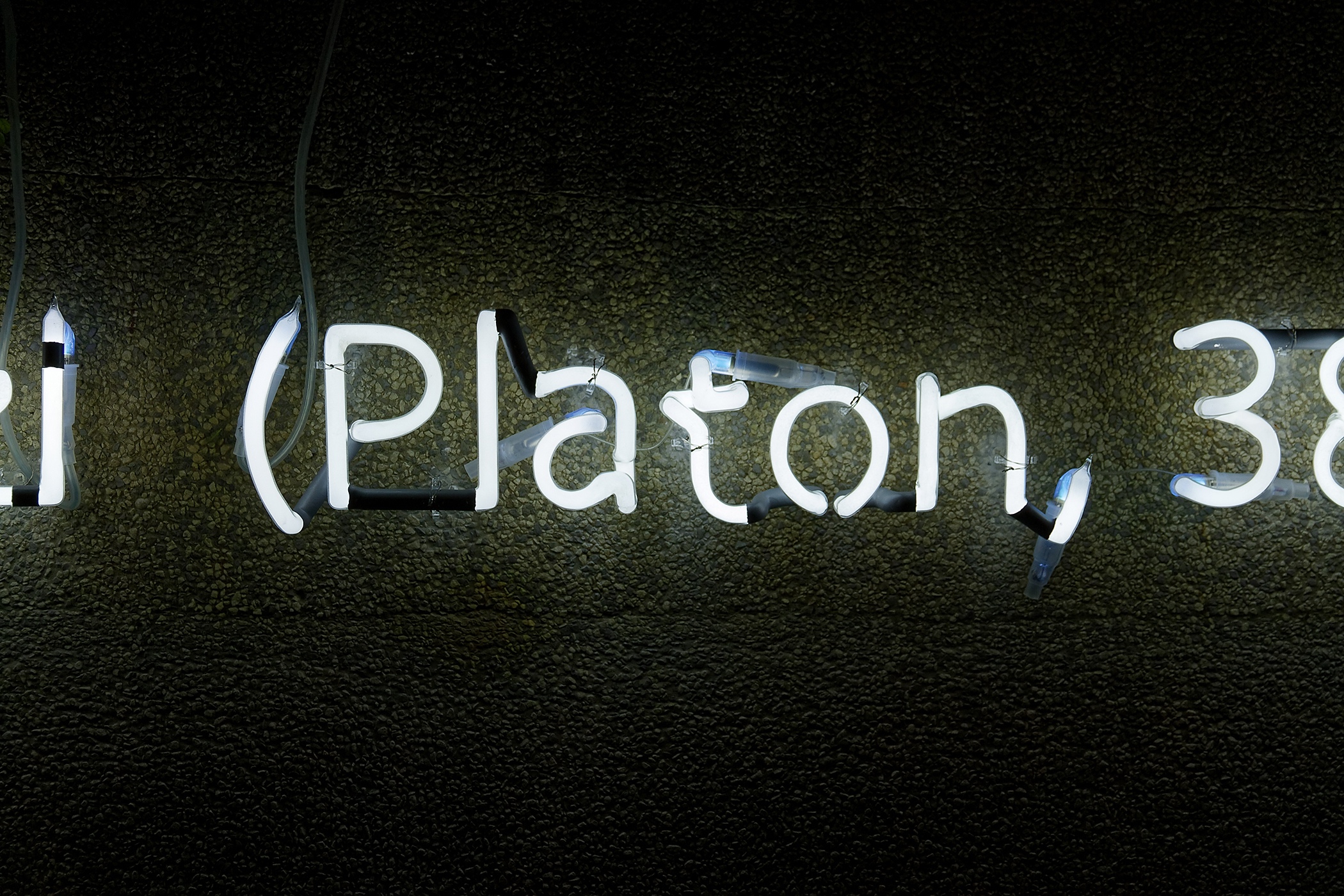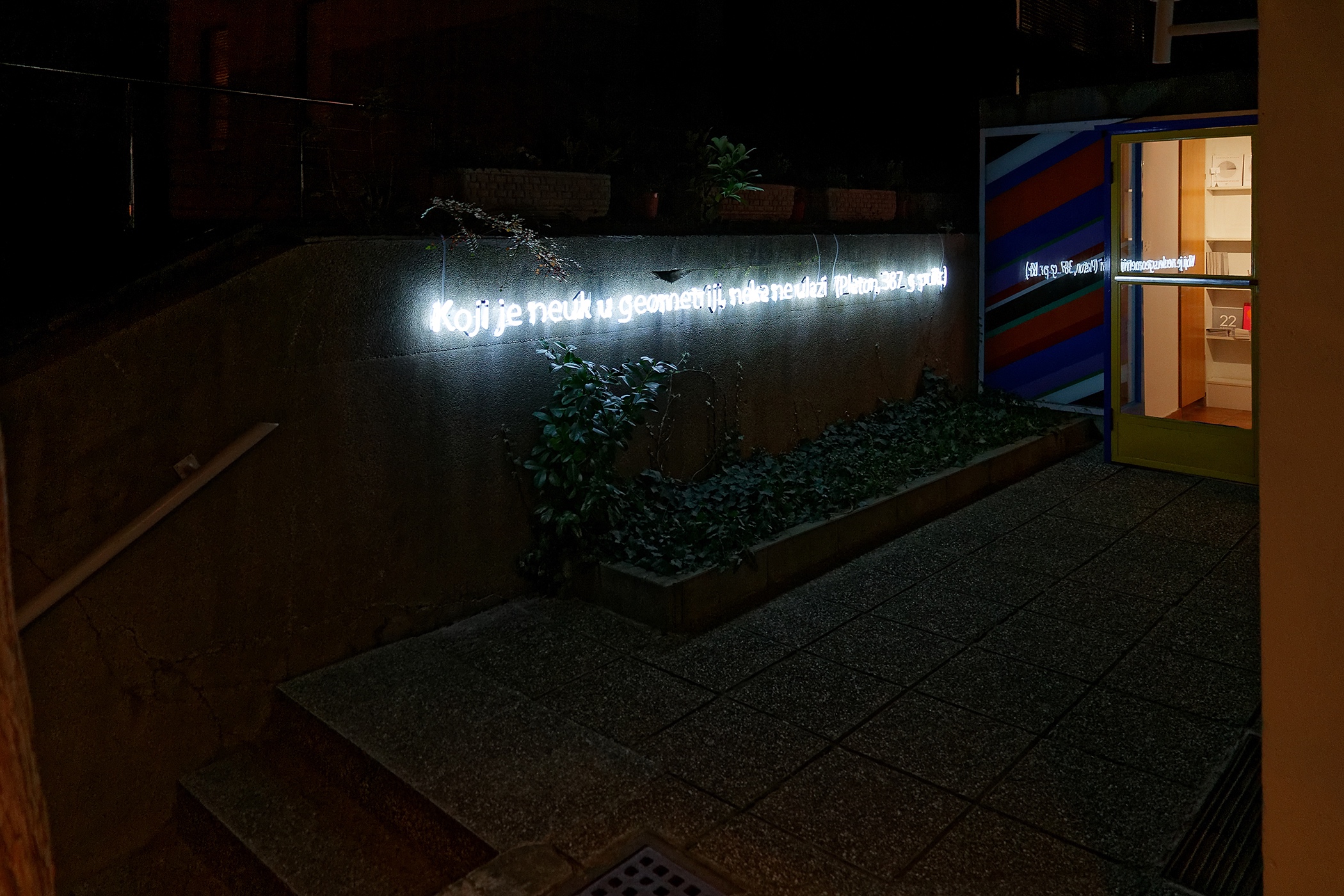Snježana Pintarić
Sintart 01 – Grupa ABS, Božena Končić Badurina, Viktor Popović, Davor Sanvincenti
Vjenceslav Richter and his wife Nada Kareš-Richter bequeathed their house with garden and artwork in 1980 to the city of Zagreb. Their wish was to keep the space preserved permanently for research of the EXAT group legacy and promotion of contemporary art production.
Our Museum took over the management of the Collection in 1998 and at once systematically we began work fulfilling the donators' wishes. The former Head of the Collection, Marijan Susovski, worked intensively from the very start on processing the donated works and preparing for their public presentation. Already in 2000, the Collection opened to the public. Soon after we began with the publishing activity as well. I should mention at least the books Gravitational Drawing (2001) and the Collection monograph (2003). Parallel to these projects, we had also extensively worked on the construction and rebuilding of the Collection and the house itself with the goal of interior remodeling and improvement of the conditions for a quality gallery showing. Meanwhile, the Collection had grown continuously with donations from various authors and so did our ambition. To the garden, in its southern corner of the property, working together with the City of Zagreb, we added a small triangular plot of land which allowed architect Richter to design a sculpture park. we introduced other smaller improvements – separate entry for the visitors, the curator room, and facility storage area. With the arrival of fellow curators Ivana Kancir and Vesna Meštrić, the operations extended into education programs – a web page was designed, and as one of our more successful actions, we should at least mention the interactive, both educational and entertaining, CD-ROM Vito and Nada. Also, Ms. Nada Kareš Richter bequeathed to the Collection the complete archives and the author's persona/library and that material will help us in the best possible way to summarize the artist's legacy.
Richter Collection is placed in a residential home that Richter build for the needs of both private and professional on the ground level, which today hosts the permanent exhibition, there was a studio, while the living area in the upper story, with its limited space, satisfied the private needs of a two-member family. Riža was very attentive to the breathing space for companionship with his friends, collaborators, and like-minded… The big table on the upper terrace that offers a view of the city, the patio in the garden with a grill, and the bocce lane – everything was designed to quickly and comfortably accommodate a larger party of guests. A simple and logical ground plan of the prefab, but by Richter's interventions, an individualized residential house, marvelously located in the verdant western portion of the city, has made our task of converting it into a public space that much easier. The collection functions well in the basic museum science sense. However, if we are to preserve and present the collection even better, allowing access to visitors with disability – we must repair the house threatened by constant landslides, and also must add features such as an elevator that would make possible direct access from Vrhovec street or the smaller summer stage. However, the project designed with these objectives in mind by architects Ana Marija Babić-Poljanec and Dunja Mandić from the Architecture Institute – will most likely have to wait for better times.'
Continually collaborating with the artist on this Collection, during the time we developed mutual trust and respect. The memories of the manner of work, thinking, and forever optimistic, creative energies of Richter, remain as an impetus and a legacy for each future probing activity of the ideal, architectural and artistic legacy of Richter's work and his overall importance for the contemporary Croatian architecture and art.
Vjenceslav Richter was an architect, urban planner, painter, printmaker, sculptor, scenographer, magazine editor, design theoretician, and experimentalist in the visual field. He was interested in mathematics and geometry; was an active culture worker (as we would call it nowadays) in various areas. Riža, until his last breath, had dedicated his life to the creative exploration of visual phenomena and unifying of visual disciplines, but also always remained a cordial and endearing human being willing to help with his support and advice. Through our work, I understood that he did not accept delays and unspecified deadlines, nor the expression "impossible" – and I also knew that, when we'd see each other and discuss issues, we will be talking about something new, of a new project. For him of great importance remained the written and expressed thought regarding the continuity of the EXAT movement's ideas: "As long as there are ATeliers which EXperiment, there will he EXATwherever we might find ourselves." For him, this thought was a guideline that might not have been agreed upon by other members of the group. However, it helped him create a balanced opus in which each new experiment, each subsequent work in a new medium, added another individual pebble in the mosaic of what could be called an experimental studio. Once, recalling the beginning of the group EXAT, Richter mentioned a lucky circumstance that helped him, Ivan Picelj, and Saša Srnec, all of them young artists at the time, find a workspace. A friend, architect Branko Bon, decided to move to Belgrade and leave behind his studio on Gajeva Street. Since the owner of the studio Alexander Freudenreich did not need the space – Richter and Picelj moved in. Srnec, who at the time still lived with his parents, soon spend whole days with them in the studio. Thanks to that lucky common "renting" later emerged EXAT group – one of the most important artistic groups of the second half of the 20th century. EXAT's and, later, New Tendencies' struggle for freedom in art, struggle for abstract art, and freedom of experiment in the area of the visuals, their insisting on the interdisciplinary visual arts, introducing the non-traditional materials and machines into a work of art; their desire for interaction and a slew of other demands, for the first time introduced into Croatian art by members of the EXAT, resulted in the individually first-rate opuses, and at the same time left an indelible impression in the whole visual culture of Croatia – from printmaking and product design to architecture and urban planning.
Led by the ideas to open the Richter Collection to a broad circle of visitors, of figuring out the new ways of its presentation and communication and different ways of activity which would make possible the development of creative potentials, we begin with the series of exhibits of contemporary artists working (or, perhaps, renting?) within the space of the Richter Collection entitled SINTART. The name derived from the series of themes that had preoccupied Richter and pointed to his ideas of the synthesis of art and the project of Sinturbanism. Vjenceslav Richter – "a human explorer of visual art galaxies" (M. Susovski) and his entire opus are an inspiration, theme, and leitmotif of the series which this year commences with six outstanding Croatian artists – Group ABS (Ivica Blažić, Josip Alebić, and Ivan Skvrce), Božena Končić-Badurina, Viktor Popović, and Davor Sanvincenti. We present six artists which have built impressive careers and which I regard highly, looking toward each of their new projects with pleasure. Knowing that this task will be somewhat of a challenge for us, without the clear notion of which direction artist concepts might evolve, this past Spring we began conversing, reading, and familiarizing ourselves with Richter's ways of existing and working. As we started the project, there arose first commentaries – the interaction between the works of art and casual passers elicited powerful excitement and tensions. So, the exhibit had not even opened, yet reactions were already pouring in. As if it were a matter of a theatrical premiere – neighbors wanting to know what type of sporting facilities we were erecting in a sculpture park!
This exhibit also, from its beginning, demanded its sequel. Some type of post-production because the projects of Božena Končić-Badurina and ABS group opened up space for further action, for a time-based activity. A time that on one hand has forgotten the concept of personal acquaintance, respect, and the exchange of ideas, and on the other hand, it also forgot silence as an important element of self-knowledge. The wall piece of Viktor Popović facing the busy street will also, I believe, not leave the passerby indifferent. It is – Plato's quote – a direct, for some perhaps even offensive message, stressing the importance of that abstract science. We already have introduced Davor Sanvincenti to our Museum recently with his fantastic audio-visual stage projects. This time, Sanvincenti intervenes with light in the Collection space but in a different, quieter manner. His optical relief presents a fine, poetic highlight on Richter's long-term experiment with light and interactive reliefmeters. The mutual understanding and respect, among the artists as well as the legacy and the new works, characterize this exhibition which into Richter Collection brings a small, but vital shift and reveals the endlessly open possibilities both for artists, as well as for us – museum "guardians of collections".
Sintart 01 – Grupa ABS, Božena Končić Badurina, Viktor Popović, Davor Sanvincenti
Vjenceslav Richter and his wife Nada Kareš-Richter bequeathed their house with garden and artwork in 1980 to the city of Zagreb. Their wish was to keep the space preserved permanently for research of the EXAT group legacy and promotion of contemporary art production.
Our Museum took over the management of the Collection in 1998 and at once systematically we began work fulfilling the donators' wishes. The former Head of the Collection, Marijan Susovski, worked intensively from the very start on processing the donated works and preparing for their public presentation. Already in 2000, the Collection opened to the public. Soon after we began with the publishing activity as well. I should mention at least the books Gravitational Drawing (2001) and the Collection monograph (2003). Parallel to these projects, we had also extensively worked on the construction and rebuilding of the Collection and the house itself with the goal of interior remodeling and improvement of the conditions for a quality gallery showing. Meanwhile, the Collection had grown continuously with donations from various authors and so did our ambition. To the garden, in its southern corner of the property, working together with the City of Zagreb, we added a small triangular plot of land which allowed architect Richter to design a sculpture park. we introduced other smaller improvements – separate entry for the visitors, the curator room, and facility storage area. With the arrival of fellow curators Ivana Kancir and Vesna Meštrić, the operations extended into education programs – a web page was designed, and as one of our more successful actions, we should at least mention the interactive, both educational and entertaining, CD-ROM Vito and Nada. Also, Ms. Nada Kareš Richter bequeathed to the Collection the complete archives and the author's persona/library and that material will help us in the best possible way to summarize the artist's legacy.
Richter Collection is placed in a residential home that Richter build for the needs of both private and professional on the ground level, which today hosts the permanent exhibition, there was a studio, while the living area in the upper story, with its limited space, satisfied the private needs of a two-member family. Riža was very attentive to the breathing space for companionship with his friends, collaborators, and like-minded… The big table on the upper terrace that offers a view of the city, the patio in the garden with a grill, and the bocce lane – everything was designed to quickly and comfortably accommodate a larger party of guests. A simple and logical ground plan of the prefab, but by Richter's interventions, an individualized residential house, marvelously located in the verdant western portion of the city, has made our task of converting it into a public space that much easier. The collection functions well in the basic museum science sense. However, if we are to preserve and present the collection even better, allowing access to visitors with disability – we must repair the house threatened by constant landslides, and also must add features such as an elevator that would make possible direct access from Vrhovec street or the smaller summer stage. However, the project designed with these objectives in mind by architects Ana Marija Babić-Poljanec and Dunja Mandić from the Architecture Institute – will most likely have to wait for better times.'
Continually collaborating with the artist on this Collection, during the time we developed mutual trust and respect. The memories of the manner of work, thinking, and forever optimistic, creative energies of Richter, remain as an impetus and a legacy for each future probing activity of the ideal, architectural and artistic legacy of Richter's work and his overall importance for the contemporary Croatian architecture and art.
Vjenceslav Richter was an architect, urban planner, painter, printmaker, sculptor, scenographer, magazine editor, design theoretician, and experimentalist in the visual field. He was interested in mathematics and geometry; was an active culture worker (as we would call it nowadays) in various areas. Riža, until his last breath, had dedicated his life to the creative exploration of visual phenomena and unifying of visual disciplines, but also always remained a cordial and endearing human being willing to help with his support and advice. Through our work, I understood that he did not accept delays and unspecified deadlines, nor the expression "impossible" – and I also knew that, when we'd see each other and discuss issues, we will be talking about something new, of a new project. For him of great importance remained the written and expressed thought regarding the continuity of the EXAT movement's ideas: "As long as there are ATeliers which EXperiment, there will he EXATwherever we might find ourselves." For him, this thought was a guideline that might not have been agreed upon by other members of the group. However, it helped him create a balanced opus in which each new experiment, each subsequent work in a new medium, added another individual pebble in the mosaic of what could be called an experimental studio. Once, recalling the beginning of the group EXAT, Richter mentioned a lucky circumstance that helped him, Ivan Picelj, and Saša Srnec, all of them young artists at the time, find a workspace. A friend, architect Branko Bon, decided to move to Belgrade and leave behind his studio on Gajeva Street. Since the owner of the studio Alexander Freudenreich did not need the space – Richter and Picelj moved in. Srnec, who at the time still lived with his parents, soon spend whole days with them in the studio. Thanks to that lucky common "renting" later emerged EXAT group – one of the most important artistic groups of the second half of the 20th century. EXAT's and, later, New Tendencies' struggle for freedom in art, struggle for abstract art, and freedom of experiment in the area of the visuals, their insisting on the interdisciplinary visual arts, introducing the non-traditional materials and machines into a work of art; their desire for interaction and a slew of other demands, for the first time introduced into Croatian art by members of the EXAT, resulted in the individually first-rate opuses, and at the same time left an indelible impression in the whole visual culture of Croatia – from printmaking and product design to architecture and urban planning.
Led by the ideas to open the Richter Collection to a broad circle of visitors, of figuring out the new ways of its presentation and communication and different ways of activity which would make possible the development of creative potentials, we begin with the series of exhibits of contemporary artists working (or, perhaps, renting?) within the space of the Richter Collection entitled SINTART. The name derived from the series of themes that had preoccupied Richter and pointed to his ideas of the synthesis of art and the project of Sinturbanism. Vjenceslav Richter – "a human explorer of visual art galaxies" (M. Susovski) and his entire opus are an inspiration, theme, and leitmotif of the series which this year commences with six outstanding Croatian artists – Group ABS (Ivica Blažić, Josip Alebić, and Ivan Skvrce), Božena Končić-Badurina, Viktor Popović, and Davor Sanvincenti. We present six artists which have built impressive careers and which I regard highly, looking toward each of their new projects with pleasure. Knowing that this task will be somewhat of a challenge for us, without the clear notion of which direction artist concepts might evolve, this past Spring we began conversing, reading, and familiarizing ourselves with Richter's ways of existing and working. As we started the project, there arose first commentaries – the interaction between the works of art and casual passers elicited powerful excitement and tensions. So, the exhibit had not even opened, yet reactions were already pouring in. As if it were a matter of a theatrical premiere – neighbors wanting to know what type of sporting facilities we were erecting in a sculpture park!
This exhibit also, from its beginning, demanded its sequel. Some type of post-production because the projects of Božena Končić-Badurina and ABS group opened up space for further action, for a time-based activity. A time that on one hand has forgotten the concept of personal acquaintance, respect, and the exchange of ideas, and on the other hand, it also forgot silence as an important element of self-knowledge. The wall piece of Viktor Popović facing the busy street will also, I believe, not leave the passerby indifferent. It is – Plato's quote – a direct, for some perhaps even offensive message, stressing the importance of that abstract science. We already have introduced Davor Sanvincenti to our Museum recently with his fantastic audio-visual stage projects. This time, Sanvincenti intervenes with light in the Collection space but in a different, quieter manner. His optical relief presents a fine, poetic highlight on Richter's long-term experiment with light and interactive reliefmeters. The mutual understanding and respect, among the artists as well as the legacy and the new works, characterize this exhibition which into Richter Collection brings a small, but vital shift and reveals the endlessly open possibilities both for artists, as well as for us – museum "guardians of collections".
2010
SintArt 01
group exhibition
Richter Collection – Museum of Contemporary Art, Zagreb, Croatia
November 4 – December 4, 2010
curator:
Snježana Pintarić
—
work exhibited:
Untitled, 2010
argon light tubes
length 400 cm
—
photo credits:
Viktor Popović
group exhibition
Richter Collection – Museum of Contemporary Art, Zagreb, Croatia
November 4 – December 4, 2010
curator:
Snježana Pintarić
—
work exhibited:
Untitled, 2010
argon light tubes
length 400 cm
—
photo credits:
Viktor Popović
14.04.2025.
© 2025 Viktor Popović
- Viktor Popović
- Exhibitions
- 2024 | Waldinger Gallery, Osijek
- 2024 | Apoteka – Space for Contemporary Art, Vodnjan
- 2024 | Technical Museum Nikola Tesla, Zagreb
- 2024 | Croatian Home, Split
- 2023 | Josip Račić Gallery, Zagreb
- 2023 | Filodrammatica Gallery, Rijeka
- 2023 | Ravne Gallery, Ravne na Koroškem
- 2023 | C24 Gallery, New York
- 2022 | A:D: Curatorial, Berlin
- 2021 | Faculty of Humanities and Social Sciences, Split
- 2021 | Cultural Institution Kula Gallery, Split
- 2020 | Health Center, Omiš
- 2020 | Armory Show, New York
- 2019 | Waldinger Gallery, Osijek
- 2019 | University Gallery Vasko Lipovac, Split
- 2019 | Museum of Fine Arts, Split
- 2018 | AŽ Gallery – Žitnjak Studios, Zagreb
- 2018 | C24 Gallery, New York
- 2017 | Multimedia Cultural Center, Split
- 2017 | Museum of Contemporary Art, Zagreb
- 2017 | Cukrarna Palace, Ljubljana
- 2015 | Salon Galić Gallery, Split
- 2015 | School Gallery, Split
- 2014 | MAP – Meeting Art Place, Brela
- 2014 | Billboard, Cista Provo
- 2013 | Split City Museum Gallery, Split
- 2013 | Lauba – People and Art House, Zagreb
- 2011 | Goli&Bosi Hostel, Split
- 2011 | City Lodge, Zadar
- 2011 | Museum of Fine Arts, Split
- 2010 | Richter Collection, Zagreb
- 2010 | St. Toma Gallery, Rovinj
- 2010 | Museum of Contemporary Art, Zagreb
- 2009 | Fonticus Gallery, Grožnjan
- 2008 | Mestrović Pavillion, Zagreb
- 2008 | The Old Printshop, Pula
- 2008 | Marganovo / Hartera, Rijeka
- 2008 | Glyptotheque, Zagreb
- 2008 | Multimedia Cultural Center, Split
- 2007 | Bačvice Aquarium, Split
- 2006 | Portland Art Center, Portland
- 2006 | City Reading Room, Komiža
- 2006 | Glyptotheque, Zagreb
- Projects
- 2024 | Untitled (Archive Fine Arts Museum)
- 2024 | Untitled (Archive Pharmacy)
- 2024 | Untitled (Archive Lynotipe)
- 2024 | Untitled (Archive Croatian Home)
- 2023 | Untitled (Archive Vranyczany-Dobrinović Palace)
- 2023 | Untitled (Archive Filodrammatica)
- 2023 | Untitled (Archive Ravne Steelworks)
- 2023 | Untitled (Monuments Archives)
- 2022 | Untitled (Archive Aperto Raum)
- 2021 | Untitled (Archive ST3: Content)
- 2021 | Untitled (Archive ST3: Content)
- 2020 | Untitled (Archive Omiš: Health Center)
- 2020 | Untitled (Archive Zenčišće)
- 2019 | Untitled (Archive ST3: Military Hospital)
- 2018 | Untitled (Archive ST3: Content)
- 2018 | Untitled (Archive ST3: Military Hospital)
- 2017 | Untitled (Archive ST3: Military Hospital)
- 2017 | Untitled
- 2015 | Untitled (Archive ST3)
- 2015 | Untitled
- 2014 | Untitled
- 2013 | Untitled
- 2011-2013 | Untitled
- 2011-2013 | Untitled
- 2007-2013 | Untitled
- 2007-2011 | Untitled
- 2010 | Untitled
- 2010 | Untitled
- 2009 | Untitled
- 2008 | Untitled
- 2008 | Untitled
- 2007 | Untitled
- 2007 | Untitled
- 2006 | Untitled
- 2006 | Untitled
- 2006 | Untitled
- Essays
- 2024 | Dalibor Prančević
- 2024 | Julija Gracin and Nevena Štokić
- 2024 | Ana Petković Basletić
- 2023 | Branko Franceschi
- 2023 | Sonja Jankov
- 2023 | Davor Mišković
- 2023 | Jernej Kožar
- 2022 | Adeline de Monseignat
- 2021 | Dalibor Prančević
- 2021 | Jasminka Babić
- 2020 | Jasminka Babić
- 2019 | Branka Benčić
- 2019 | Branko Franceschi
- 2017 | Nataša Ivančević
- 2017 | Jasminka Babić
- 2015 | Jasminka Babić
- 2014 | Jasminka Babić
- 2013 | Jasminka Babić
- 2012 | Ksenija Orelj and Sabina Salomon
- 2011 | Jasminka Babić
- 2008 | Ksenija Orelj
- 2007 | Klaudio Štefančić
- 2004 | Jasminka Babić
- 2004 | Dalibor Prančević
- CV
- Contact
- Sitemap
© 2025 Viktor Popović
